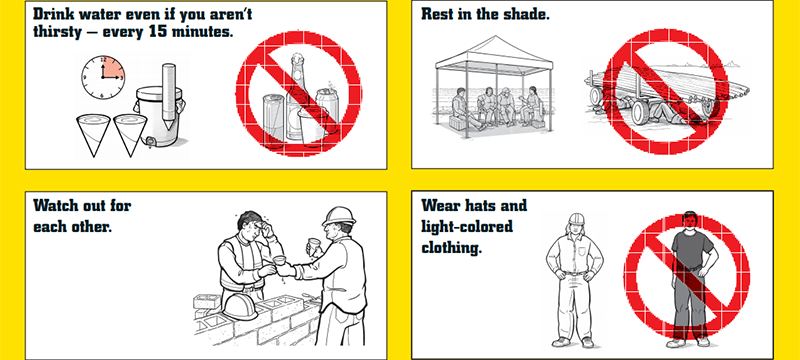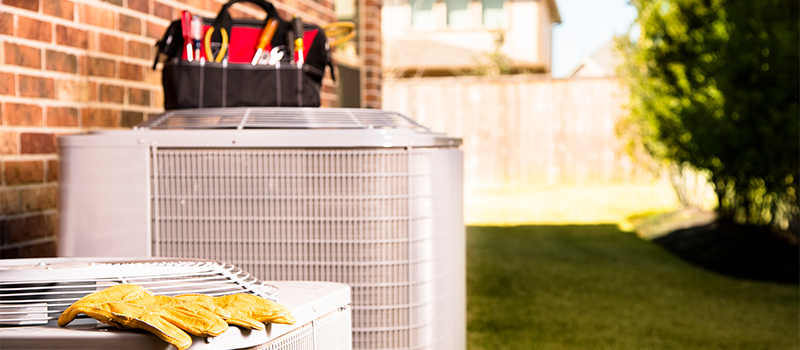Six months ago, people who work outdoors or in other areas exposed to the elements were anxious for things to warm up in most areas of the country. Now, the pendulum has swung to the other extreme and many workers need relief from the heat.
Keeping workers safe in extreme heat is more than just an issue of comfort. It can be a matter of life and death.
Dozens of people die each year and thousands get sick on the job because of heat-related issues, according to the Occupational Safety and Health Administration (OSHA). It also has a program to prevent heat illness called “Water. Rest. Shade.”
This program explicitly highlights the need for employees to drink water and take periodic rests in the shade to cool down. Below is a graphic from OSHA’s website about this program. The full Health Effects of Heat Worksite Training Poster can be found here.

Source: https://www.osha.gov/SLTC/heatillness/3431_wksiteposter_en.pdf
Workers in a variety of industries can be affected by the heat. These include the obvious kinds of outdoor workers (farms, construction, landscaping, etc.) as well as employees who face high indoor temperatures or strenuous indoor work in places like factories, foundries, kitchens, and mines.
Whether at work or elsewhere, heat works the same way on our bodies. We sweat to keep our body temperature where it’s supposed to be, but when the environment around us gets too hot and/or humid, this becomes more difficult. If we don’t cool down, we can develop various illnesses including heat stroke, which can be fatal if not treated immediately.
The heat index, which combines temperature and humidity, is one common tool suggested by OSHA as employers try to ensure workers are safe. The guidelines range from caution when the heat index is lower than 91 degrees Fahrenheit to very high/extreme when it is higher than 115 degrees. Working in the sunlight, wearing heavy clothing, or performing strenuous work increases the risk and requires a higher level of caution.
As the heat rises, OSHA recommends the following precautions:
- Drink small amounts of water frequently.
- Water is a vital tool to prevent heat-related problems. For optimal results, the water needs to be conveniently located so workers can drink smaller amounts throughout the shift rather than large quantities irregularly. A beverage designed to replace lost electrolytes also can be a good tool.
- Water is a vital tool to prevent heat-related problems. For optimal results, the water needs to be conveniently located so workers can drink smaller amounts throughout the shift rather than large quantities irregularly. A beverage designed to replace lost electrolytes also can be a good tool.
- Wear light-colored, loose-fitting, breathable clothing.
- Some tasks require workers to wear heavy or specialized clothing, but wearing the right clothing for conditions when the job allows is a great step to prevent heat problems.
- Some tasks require workers to wear heavy or specialized clothing, but wearing the right clothing for conditions when the job allows is a great step to prevent heat problems.
- Take frequent short breaks in cool shade.
- Just cooling down for a few minutes can work wonders, especially when combined with water.
- Just cooling down for a few minutes can work wonders, especially when combined with water.
- Eat smaller meals before work activity.
- Anyone who has exercised knows hard physical activity is difficult on a full stomach. Planning is key.
- Anyone who has exercised knows hard physical activity is difficult on a full stomach. Planning is key.
- Avoid caffeine and alcohol or large amounts of sugar.
- In addition to quantity of food and drink, workers should be careful about quality.
- In addition to quantity of food and drink, workers should be careful about quality.
- Work in the shade.
- If possible, working out of the direct sunlight and outside of times of peak heat helps.

- Find out if your medications and heat don’t mix.
- Some medications, such as antibiotics and some antidepressants and heart medications, can cause sensitivity to the sun. Workers should check medicine labels or check with their doctor or pharmacist.
- Some medications, such as antibiotics and some antidepressants and heart medications, can cause sensitivity to the sun. Workers should check medicine labels or check with their doctor or pharmacist.
- Know that equipment such as respirators and work suits can increase heat stress.
- Be extra careful if you’re wearing heavy or sealed clothing.
New workers are particularly vulnerable to heat-related issues as their bodies get acclimated. Thus, employers should give both new and returning workers in hot environments lighter workloads or more frequent breaks to avoid serious problems.
Employers also should consider schedules that incorporate additional rest periods, encourage duty rotation where possible, and ask workers to keep an eye on each other for early warning signs such as heavy sweating, nausea, dizziness, weakness, irritability, and thirst. Finally, having emergency plans in place is key to handling problems if they arise.
Appropriately managing heat risks in the workplace is important for employee safety as well as preventing downtime and maintaining efficiency.
.png?width=131&height=58&name=image%20(40).png)
